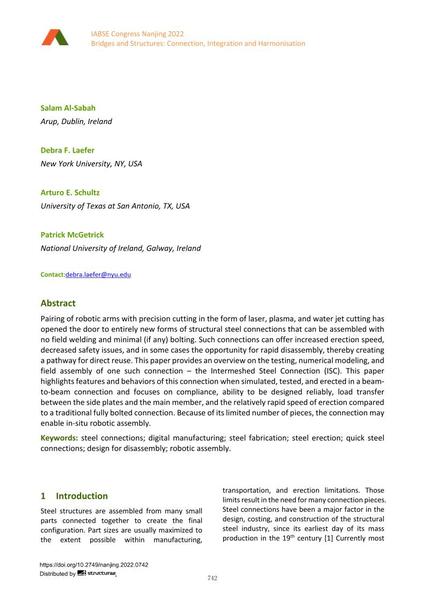Advances in and Benefits of Rapid Steel Connections

|
|
|||||||||||
Bibliografische Angaben
| Autor(en): |
Salam Al-Sabah
(Arup, Dublin, Ireland)
Debra F. Laefer (New York University, NY, USA) Arturo E. Schultz (University of Texas at San Antonio, TX, USA) Patrick McGetrick (National University of Ireland, Galway, Ireland) |
||||
|---|---|---|---|---|---|
| Medium: | Tagungsbeitrag | ||||
| Sprache(n): | Englisch | ||||
| Tagung: | IABSE Congress: Bridges and Structures: Connection, Integration and Harmonisation, Nanjing, People's Republic of China, 21-23 September 2022 | ||||
| Veröffentlicht in: | IABSE Congress Nanjing 2022 | ||||
|
|||||
| Seite(n): | 742-749 | ||||
| Anzahl der Seiten (im PDF): | 8 | ||||
| DOI: | 10.2749/nanjing.2022.0742 | ||||
| Abstrakt: |
Pairing of robotic arms with precision cutting in the form of laser, plasma, and water jet cutting has opened the door to entirely new forms of structural steel connections that can be assembled with no field welding and minimal (if any) bolting. Such connections can offer increased erection speed, decreased safety issues, and in some cases the opportunity for rapid disassembly, thereby creating a pathway for direct reuse. This paper provides an overview on the testing, numerical modeling, and field assembly of one such connection – the Intermeshed Steel Connection (ISC). This paper highlights features and behaviors of this connection when simulated, tested, and erected in a beam- to-beam connection and focuses on compliance, ability to be designed reliably, load transfer between the side plates and the main member, and the relatively rapid speed of erection compared to a traditional fully bolted connection. Because of its limited number of pieces, the connection may enable in-situ robotic assembly. |
||||
| Stichwörter: |
digitale Produktion
|
||||
| Copyright: | © 2022 International Association for Bridge and Structural Engineering (IABSE) | ||||
| Lizenz: | Die Urheberrechte (Copyright) für dieses Werk sind rechtlich geschützt. Es darf nicht ohne die Zustimmung des Autors/der Autorin oder Rechteinhabers/-in weiter benutzt werden. |
||||
